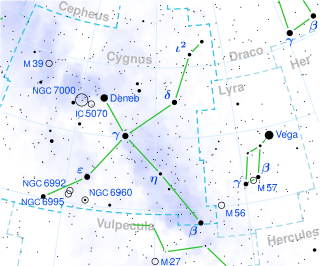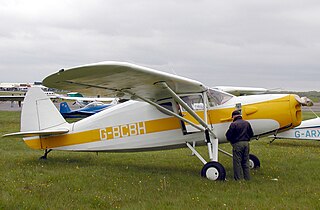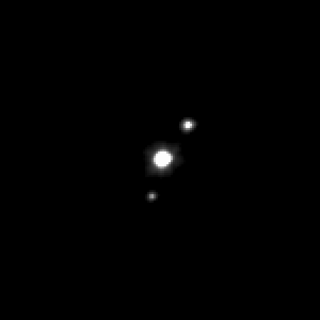
61 Cygni is a binary star system in the constellation Cygnus, consisting of a pair of K-type dwarf stars that orbit each other in a period of about 659 years. Of apparent magnitude 5.20 and 6.05, respectively, they can be seen with binoculars in city skies or with the naked eye in rural areas without photopollution.

The Curculionidae are a family of weevils, commonly called snout beetles or true weevils. They are one of the largest animal families, with 6,800 genera and 83,000 species described worldwide. They are the sister group to the family Brentidae.

A biogeographic realm or ecozone is the broadest biogeographic division of Earth's land surface, based on distributional patterns of terrestrial organisms. They are subdivided into bioregions, which are further subdivided into ecoregions.

Dioscoreaceae is a family of monocotyledonous flowering plants, with about 715 known species in nine genera. The best-known member of the family is the yam.

Messier 61 is an intermediate barred spiral galaxy in the Virgo Cluster of galaxies. It was first discovered by Barnaba Oriani on May 5, 1779, six days before Charles Messier discovered the same galaxy. Messier had observed it on the same night as Oriani but had mistaken it for a comet. Its distance has been estimated to be 45.61 million light years from the Milky Way Galaxy. It is a member of the M61 Group of galaxies, which is a member of the Virgo II Groups, a series of galaxies and galaxy clusters strung out from the southern edge of the Virgo Supercluster.

Neogastropoda is an order of sea snails, both freshwater and marine gastropod molluscs.

Ailuridae is a family in the mammal order Carnivora. The family consists of the red panda and its extinct relatives.

The Fairchild Model 24, also called the Fairchild Model 24 Argus and UC-61 Forwarder, is a four-seat, single-engine monoplane light transport aircraft designed by the Fairchild Aviation Corporation in the 1930s. It was adopted by the United States Army Air Corps as UC-61 and also by the Royal Air Force. The Model 24 was itself a development of previous Fairchild models and became a successful civil and military utility aircraft.

Haumea is a dwarf planet located beyond Neptune's orbit. It was discovered in 2004 by a team headed by Mike Brown of Caltech at the Palomar Observatory in the United States and disputably also in 2005 by a team headed by José Luis Ortiz Moreno at the Sierra Nevada Observatory in Spain, though the latter claim has been contested. On September 17, 2008, it was named after Haumea, the Hawaiian goddess of childbirth, under the expectation by the International Astronomical Union (IAU) that it would prove to be a dwarf planet. Nominal estimates make it the third-largest known trans-Neptunian object, after Eris and Pluto, though the uncertainty in best-fit modeling slightly overlaps with the larger size estimates for Makemake.
HD 91942 is a single variable star in the constellation Carina. It has the Bayer designation r Carinae, while HD 91942 is the identifier from the Henry Draper catalogue. This orange-hued object is visible to the naked eye with an apparent visual magnitude of 4.45. Based on parallax measurements, it is located at a distance of approximately 1,180 light years from the Sun. The star has an absolute magnitude of −3.77, and is drifting further away with a radial velocity of +9.9 km/s.

Pyraustinae is a large subfamily of the lepidopteran family Crambidae, the crambid snout moths. It currently includes over 1,400 species; most of them tropical but some found in temperate regions including both North America and Europe.
Cecil Airport is a public airport and commercial spaceport located in Jacksonville, Florida, United States. It is owned by the Jacksonville Aviation Authority and services military aircraft, corporate aircraft, general aviation, and air cargo. The Florida Army National Guard's primary Army Aviation Support Facility and the U.S. Coast Guard's Helicopter Interdiction Tactical Squadron (HITRON) are also located here, the former operating CH-47 Chinook, UH-60 Blackhawk, UH-72 Lakota and C-12 Huron aircraft, and the latter operating the MH-65C Dolphin helicopter.

Pentarthrum huttoni is a species of wood boring weevil in family Curculionidae. It has a mainly nearctic distribution, but has also been reported from several European countries. It was first reported in Austria in 2006 when it was found to be the cause of disintegration of historically significant 18th century softwood coffins in the crypt of St. Michael's church in the center of Vienna.

Trigonostoma is a genus of sea snails, marine gastropod mollusks in the family Cancellariidae, the nutmeg snails.

Dryotribini is a tribe of beetles in the subfamily Cossoninae.

Quaker Harbour is the irregularly shaped bay indenting for 3.7 km the north coast of Weddell Island in the Falkland Islands. It is centred at 51°49′00″S61°04′35″W, and has its head fed by Pitt Creek. The bay takes its name from nearby Quaker Island.

Margaroniini is a tribe of the species-rich subfamily Spilomelinae in the pyraloid moth family Crambidae. The tribe was erected by Charles Swinhoe and Everard Charles Cotes in 1889.

United States gubernatorial elections were held in 1804, in 13 states, concurrent with the House, Senate elections and presidential election.
United States gubernatorial elections were held in 1810, in 13 states, concurrent with the House and Senate elections.
United States gubernatorial elections were held in 1806, in 10 states, concurrent with the House and Senate elections.
















